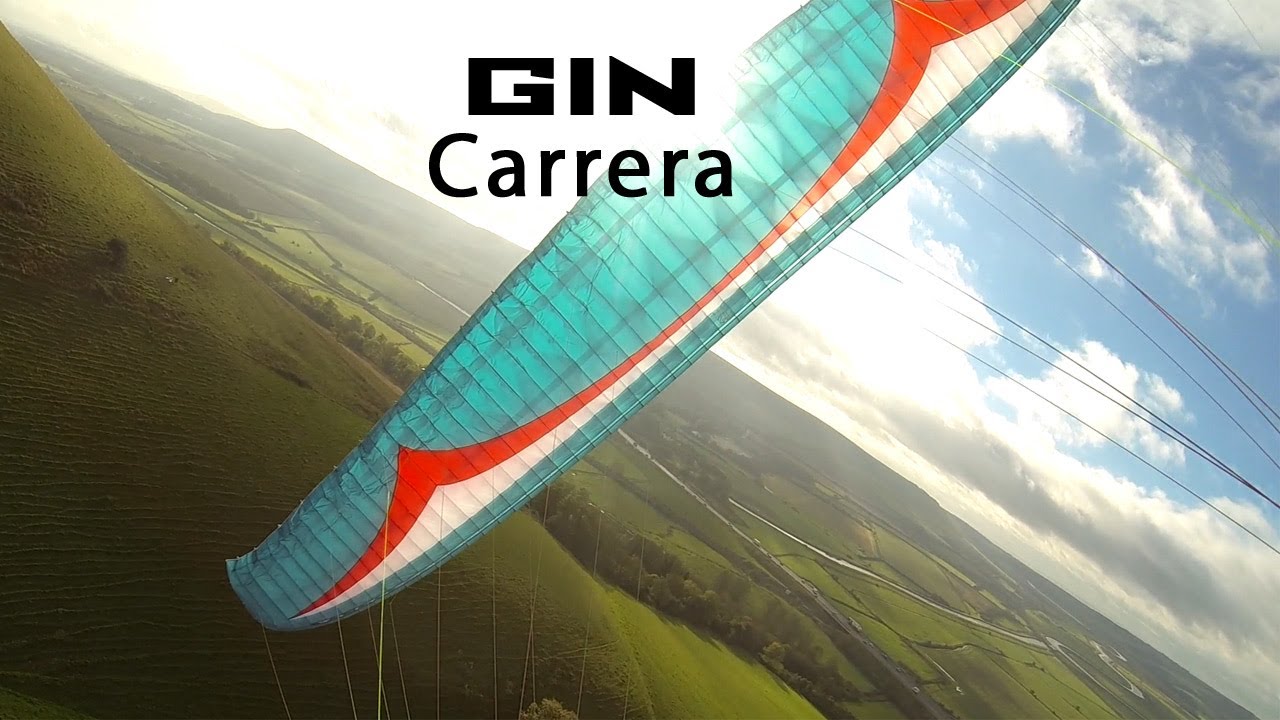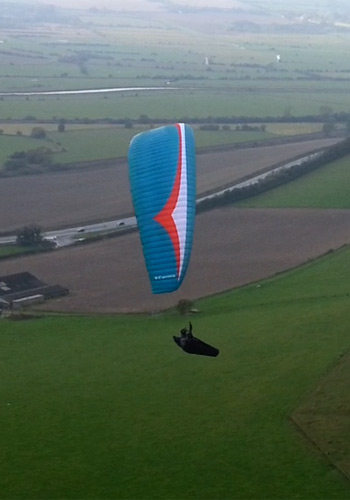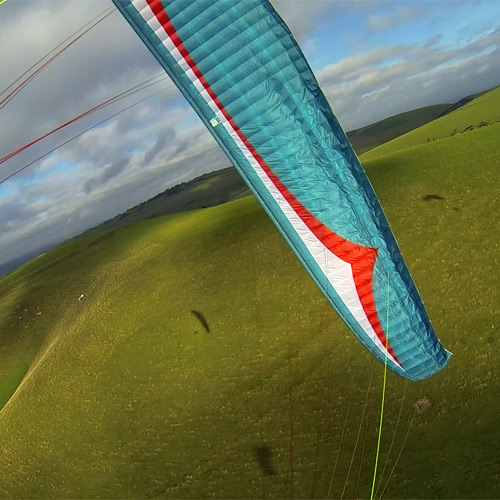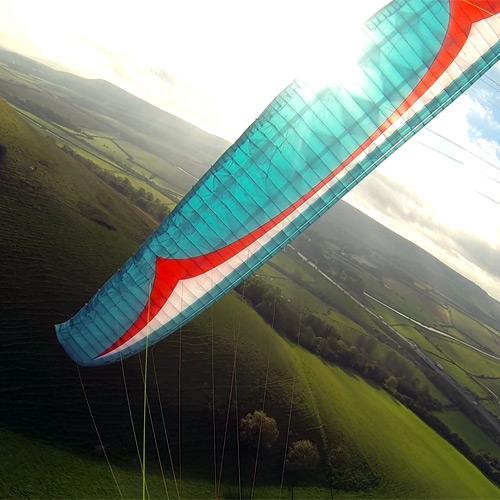
Paragliding review of the new Gin Carrera (EN B) paraglider by Flybubble's Carlo Borsattino. Of their new wing Gin Gliders say: "The Carrera is a performance wing that offers sporty handling and real-world performance in a highly accessible package. It replaces the Tribe (EN C) in our paraglider range." However the Carrera has been certified EN B, very surprising considering it has a flat aspect ratio of 6.2, higher than most EN C rated wings! So where does the Carrera sit in the paragliding spectrum when in comes to pilot demands? Is it a high B or a hot B? What level of paraglider pilots is it best suited to? Carlo, a highly experienced paraglider pilot and wing reviewer, gives his first impressions.

The Carrera is a very clean looking wing, with excellent all-round construction. It definitely looks and feels part of the same family as the Gin Atlas and Boomerang 9.
In the very strong wind I found the Carrera a little hard to hold down before launch. Similar to it's little brother, the Atlas, it really wants to come up and fly! I needed to use the brake lines and rear risers together (a technique which works for most wings, and I use a lot). It was quite windy and gusty though.
Maybe partly due to the conditions but the Carrera came up pretty fast on launch and needed precise input to manage. On my first launch I tried to launch like a 'B pilot' and got plucked off my feet and had a 50% collapse, which re-inflated quickly (partly down to pilot input). I changed to C pilot mode for my following launches, being a bit more 'on it', and then it was AOK.
In the air, I found the Carrera's brake pressure moderate to a bit on the heavy side. The grip balls on the brake handles were appreciated and I soon found myself flying holding these all of the time. Because of its relatively high brake pressure it feels at first like the Carrera has relatively short brake travel for a B, however on further investigation I found it can withstand a surprising amount of brake input. The brake contact point (when the slack in the brake line is taken out, and the brakes start to take effect) is around 10 cm, which is relatively short compared to most Bs. I didn't need wraps to reach the Carrera's stall/spin point however I found that it took much more brake than at first I expected and the wing gave good warning before it stalled; this was not overtly sudden or unexpected. The Carrera doesn't feel like a wing which is going to be very forgiving of ham-fisted pilot inputs, but it's certainly more forgiving and easier to manage than you might expect for a wing with such a high aspect ratio: 6.2!

The Carrera responds to brake inputs quickly and with plenty of energy. It feels super-efficient. Very easy to turn flat; relatively easy to crank and bank. It's relatively very high aspect ratio and shorter chord means that the Carrera demands more precise input from the pilot to turn tightly without the risk of spinning it compared to a lower aspect ratio wing, but it's a lot more forgiving than might initially be expected. The Carrera is great fun to wing over and dolphin! I look forward to smoother conditions and more height to play with it some more.

A very solid feeling wing, the Carrera's Sail gives the impressions of being very taught and highly tuck resistant.
Standard big-ears are relatively easy to induce on the Carrera, using the outer A's. They are very effective, giving a noticeable increase in descent rate, and relatively stable. The big-ears stay in, with no tendency to come out on their own, and required quite a bit of pumping to clear. They showed a slight tendency for the tips to get caught in the lines on release, but this was easy to clear.
I also tried the 'tip-stall' mild descent technique, using the B3s. This was more fiddly to induce than standard big-ears, as there is no split line so you have to grab the B3 lines inside the stabilo lines, but seemed to work well. Although the tip-stall descent technique is neater than standard big-ears (the wing tips don't flap around), and it generally comes out more cleanly, the downsides are that it's harder to hold in, due to the higher pressure, and not quite as effective i.e. the descent rate is less. Perhaps it's just me but, I always feel like there's more chance of the whole wing stalling using the tip-stall descent technique, on any wing, compared to standard big-ears, so I generally prefer to accelerate the wing when using the tip-stall technique by applying some speed bar.
I didn't have enough height to test real big collapses in real conditions but I did induce a few small collapses (more like big big ears) which were fairly benign.
Not scientifically measured ;) but the general performance of the Carrera feels very, very good indeed. Sink rate felt very good (although I did notice with some annoyance that Nancy was still staying up above me most of the time on the Chili 3). Speed and glide felt exceptional for the B class, perhaps even compared to current C wings. TBC.
The Carrera's speed system has a moderate pressure, and feels very efficient. Very fast for a B wing, with excellent glide. I couldn't quite get full bar as my speed system was set up a bit too long. Next time!
First feelings from my first flights: A very impressive all-round XC wing!

The Carrera is definitely the hottest EN B wing I've flown to date. It feels and flies much more like a C than a B, which is not entirely surprising for a wing with an aspect ratio higher than most C wings! Best suited to highly experienced XC pilots 'stepping down' from a C or D wing, or up from a high B wing. Absolutely NOT suitable as a first wing!
The Flybubble team need to test fly the Carrera some more in a wider variety of conditions to get a fuller picture. Our opinion might change, so contact us directly for the latest information if you’re considering buying one.
Carlo flew the Carrera size M at an all-up weight of 102 Kg in windy, gusty pre-frontal conditions with sometimes rather lumpy, holey air. He stopped testing to save a low airtime pilot, see our video: Paragliding Safety: How to Avoid the Rotor
Find out more about the Gin Carrera
Watch our Gin Carrera review video:
Update, 11 November 2013: Carlo flew the Gin Carrera high performance XC wing again yesterday. Here are his further thoughts about it:
I got to fly the Carrera again yesterday, this time in a wider range of flying conditions; starting with strong wind and light thermals, going to progressively lighter winds until it got quite scratchy and even too light to stay up at times. I also managed to play around with it on the ground quite a bit, testing its launch and ground handling characteristics and getting to know it better. In summary: The Carrera is very, very impressive indeed!
The Carrera's launch and ground handling characteristics are very impressive for its relatively high aspect ratio and level of performance.
Thinking further about my first flights and impressions, I reckon it was the Carrera's relatively high brake pressure, coupled with the marginal conditions I was flying in, which meant I felt less inclined to test the brake travel and stall point as thoroughly as I would normally like to. This gave me the wrong first impression about the Carrera's brake travel and stall point, which I now think is a lot longer and more forgiving than I initially thought it was. On further testing, the brake travel is average, not short, and the Carrera is fairly tolerant of deeper brake.
We've added some text annotations to our Carrera 'first flight' review video, and I've updated my Carrera review text, accordingly. I also updated the bit about big ears in the review text, and added something about the tip-stall descent technique using B3s.
We need to test more to confirm but so far Greg and I think the Carrera is certainly the highest performing EN B wing to date!
Find out more about the Gin Carrera
Brought to you by Flybubble
Want to see more? There’s no better way to support our efforts than buying from us. We’ll ensure you get great service! Choose from our great range AND enable us to produce more videos and articles to benefit the freeflight community.

